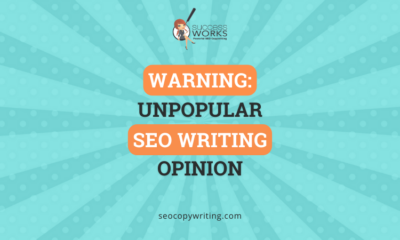MARKETING
PPC In 2020: 2 Experts Weigh In On Future Trends [Video]
Within our daily work lives at Hanapin, we have so many interesting PPC discussions across desk pods, at lunch, or through video chats. To be a fly on the wall for those conversations would be an informative experience! We want to bring some of those fascinating conversations to PPC Hero for our readers.
In this video, Hanapin’s Dani Gonzales and John Williams discuss the future of PPC and what’s on their wishlists for 2020.
Transcription
Dani:
Today we’re going to chat about the future of PPC. I’m joined by my coworker John Williams and before we fully dive in here we’ll go ahead and introduce ourselves.
I am a senior account manager here at Hanapin and I focus a lot on led gen campaigns particularly in B2B verticals, and I’m excited to share some fun stuff today.
John:
I’m John. I’ve been around for about 10 years in the digital industry and with Hanapin since July, which was a dream for me. I love everything whether it’s tag management, analytics, or paid search.
Dani:
You’ve been in the industry over 10 years, over that time what trends have surprised you the most in PPC?
John:
You can probably talk about the difference between using a PC or a Mac now and looking at an ad or you can talk about Google my business listings, or the 3-pack. There’s a lot that you can talk about, but for me, the absolute biggest has probably been attribution. We’ve always talked about it, but we didn’t really know what it was. Is it linear, is it time decay? Is a customer at the top of the funnel, are they at the bottom of the funnel? I think all of that’s out the door. I think we have to start looking at it a different way and I think a lot of the products that we’re using today are saying, look customers are over here on the left, and then on the top, and then they’re down here at the bottom. I think that’s the biggest for me is that the biggest change has been the progression of attribution and the technology behind it.
Dani:
I have to agree a little bit on the technology side.
So I’ve been in the industry less time than you just over three and a half years now and I think the thing that continually surprises me is that more and more we have access to so much data; audience data, demographic data, tons of micro bits of data, but we still struggle to report accurately across all the different data points we have from merging our client CRM data with what we’re seeing in the platform’s themselves. So I think that’s the one thing that I’m continually flummoxed by is how is it possible that we don’t have a really great source of truth for all of this information. Of course, I’m aware of the myriad of ad reporting software that’s available, but at the same time, it’s still something that I think is really surprising to me.
When you look ahead to 2020, is there anything that particularly excites you in the world of PPC? Any particular trends, features, consumer information – anything that you’re excited about?
John:
Yes, and no. I’m not really excited about all of the changes that are coming here to the US that means that as advertisers were going to start to see a lot of lot more propaganda on LinkedIn and Twitter about how something should be implemented or these leads aren’t really valid or are you doing this? So that doesn’t excite me.
What does excite me is that we’re learning how to be smarter advertisers. Meaning we’re asking better questions about our data from a strategy perspective. Everybody’s got an answer, everybody’s right. But you can’t always be right and I think we’re now starting to realize that as marketers, not just digital advertisers, that we need an objective that should be followed up with a strategy that helps us with the tactic.
Google’s walking along with us and so is Microsoft and our other partners that we have; they’re saying, stop doing all of the tactics in the day-to-day and start focusing on the things that actually matter. So that’s what excites me about going into 2020, I think we’ll see a lot more of that.
Dani:
My excitement goes along a similar trendline in terms of the automation features that we have available across managing all of our platforms. We can really hone in on the creative piece and focus on strategy and focus on the things that I think are really going to matter in 2020. Moving beyond, as all of these platforms get a lot more automated and we’re kind of letting go of the reins, there’s a couple of key pieces that we’re going to have to maintain really tight control of, and for me that’s creative and landing pages.
That’s going to be the place as advertisers we’re really going to be able to make a mark for our clients or if you’re doing your own digital advertising make a mark for yourself. I think really focusing on the creative components and the landing page experience is going to be a huge bit of what is going to make advertisers successful in 2020.
John:
Do you want to learn markup in HTML?
Dani:
No, I don’t know who wants to learn that but again, if it’s going to be a key component of helping our clients be more successful or at least being able to venture into the world of CRO and really get some solid multivariate testing on what’s going to work on landing pages for those individual clients. I don’t think we have to necessarily learn that ourselves as long as we have developers in our corner working on that and providing really strong testing results.
Again, I think the landing page experience is going to be a huge part of 2020 and we’ve seen that of course throughout the last few years with mobile AMP pages and all kinds of different landing page experiences. I think CRO is going to play a much larger role or we’re going to have to give it more credit than we may historically have.
If you could get Google and/or Facebook to make one huge update in 2020, what would it be?
John:
The biggest thing would probably be in Google. I love scripts, I want to learn JavaScript and python, I want to spend all my time doing that, but Google already has rules. So Google if you’re listening, you have rules. They function every 24 hours, can you just adjust it so that we can implement that every 12 hours? I would take that, but I would love to see the biggest change being rules changed to hourly so that we can start to work on things that matter for our clients and stop worrying about if we’re going to go over by 10% or worrying about coming up with a script that we need to calculate at 30% over or 30% under. Can we just get over that and utilize your tool and what you built it for?
Dani:
My number one wish list item, this comes up a lot especially again kind of coming back to the theme of automation and the more we implement automated pieces, we need data to make that possible. So we’re looking at the future of conversions. What does that look like? Do we start implementing micro-conversions so that we can get more data so those algorithms can be more powerful and we can use more of that machine learning? But within doing that, how we’re kind of rethinking what a conversion is and how we calculate this measure of success, I would really love if Google would just show me the corresponding data metrics with my conversion actions. Currently, if you have multiple conversion actions live in an account you can’t see the corresponding impressions, clicks, spend that was associated with those conversion actions. You can see the total and that’s it. So Google people if you are listening, please let me see key metrics alongside my conversion actions. It’s so little and I know you know it, and I know you have this information.
John:
You have to, you’re showing it in Google Analytics, so come on, give it to us. Just put it in one place. Why do we have to go to three places to look for things? One place, yes please.
Dani:
Anything else on your PPC wish list?
John:
It’d be great if we just had one tool. We have to go to too many places for reporting, for measurements, and then to take action. And we can’t afford it. Not everybody can afford an Adobe stack or Google marketing platforms. We can’t afford that and we shouldn’t have to use a third-party tool that interjects into our account to provide us with suggestions. It would be great if we had one tool that you can go in and see everything and do everything.
Dani:
To recap we want fewer tools overall, better tracking, and what was yours? More data analytics?
John:
The tracking, the measurements, and the tactic.
Dani:
And merging all of that into a cohesive story for your client is also pretty hard when you have to implement all of the different data points from all of the different platforms, which may or may not have similar attribution. You’re kind of running in a circle trying to present a really strong story that backs up your data, but then it’s really hard to plug it all in, get it centralized, and have it make sense in a way that’s really palatable.
John:
If it was your last ornament, what would that be? What would that last little thing that you wanted to like cap off your tree with for the holidays?
Dani:
I guess less from a platform perspective, but I want more of my clients doing video, higher quality video and focusing more on that. We’ve seen for some of my clients some really impressive brand lifts as a result. I think the better quality targeting that we’ve had in YouTube over the past year and some of the new capabilities like custom intent are really cool. I think that’s where I’d like to see that little ornament. A little shiny cherry on top would be just more video coming down from for my clients in particular.
John:
I like it. It takes a lot of work, but it is the brand appeal and how we’re moving away from TV and how we’re looking at the social components of things – it is 3 to 6-second bursts.
Dani:
I’m always troubled by clients being wary of YouTube or not wanting to run YouTube ads. For decades you were okay running TV ads when you have no idea who you’re targeting per se. We have so much more data we can get a lot more localized we can get a lot more segmented and that scares clients. I think it’s kind of funny reverse logic there. But I’m a big fan of YouTube, a big fan of running ads in that platform, especially given a lot of its more recent improvements.
Thanks again for listening everyone and we hope you join us again.
MARKETING
Tinuiti Marketing Analytics Recognized by Forrester

Rapid Media Mix Modeling and Proprietary Tech Transform Brand Performance
Tinuiti, the largest independent full-funnel performance marketing agency, has been included in a recent Forrester Research report titled, “The Marketing Analytics Landscape, Q2 2024.” This report comprehensively overviews marketing analytics markets, use cases, and capabilities. B2C marketing leaders can use this research by Principal Analyst Tina Moffett to understand the intersection of marketing analytics capabilities and use cases to determine the vendor or service provider best positioned for their analytics and insights needs. Moffett describes the top marketing analytics markets as advertising agencies, marketing dashboards and business intelligence tools, marketing measurement and optimization platforms and service providers, and media analytics tools.
As an advertising agency, we believe Tinuiti is uniquely positioned to manage advertising campaigns for brands including buying, targeting, and measurement. Our proprietary measurement technology, Bliss Point by Tinuiti, allows us to measure the optimal level of investment to maximize impact and efficiency. According to the Forrester report, “only 30% of B2C marketing decision-makers say their organization uses marketing or media mix modeling (MMM),” so having a partner that knows, embraces, and utilizes MMM is important. As Tina astutely explains, data-driven agencies have amplified their marketing analytics competencies with data science expertise; and proprietary tools; and tailored their marketing analytics techniques based on industry, business, and data challenges.
Our Rapid Media Mix Modeling sets a new standard in the market with its exceptional speed, precision, and transparency. Our patented tech includes Rapid Media Mix Modeling, Always-on Incrementality, Brand Equity, Creative Insights, and Forecasting – it will get you to your Marketing Bliss Point in each channel, across your entire media mix, and your overall brand performance.
As a marketing leader you may ask yourself:
- How much of our marketing budget should we allocate to driving store traffic versus e-commerce traffic?
- How should we allocate our budget by channel to generate the most traffic and revenue possible?
- How many customers did we acquire in a specific region with our media spend?
- What is the impact of seasonality on our media mix?
- How should we adjust our budget accordingly?
- What is the optimal marketing channel mix to maximize brand awareness?
These are just a few of the questions that Bliss Point by Tinuiti can help you answer.
Learn more about our customer-obsessed, product-enabled, and fully integrated approach and how we’ve helped fuel full-funnel outcomes for the world’s most digital-forward brands like Poppi & Toms.
The Landscape report is available online to Forrester customers or for purchase here.
MARKETING
Ecommerce evolution: Blurring the lines between B2B and B2C

Understanding convergence
B2B and B2C ecommerce are two distinct models of online selling. B2B ecommerce is between businesses, such as wholesalers, distributors, and manufacturers. B2C ecommerce refers to transactions between businesses like retailers and consumer brands, directly to individual shoppers.
However, in recent years, the boundaries between these two models have started to fade. This is known as the convergence between B2B and B2C ecommerce and how they are becoming more similar and integrated.
Source: White Paper: The evolution of the B2B Consumer Buyer (ClientPoint, Jan 2024)
What’s driving this change?
Ever increasing customer expectations
Customers today expect the same level of convenience, speed, and personalization in their B2B transactions as they do in their B2C interactions. B2B buyers are increasingly influenced by their B2C experiences. They want research, compare, and purchase products online, seamlessly transitioning between devices and channels. They also prefer to research and purchase online, using multiple devices and channels.
Forrester, 68% of buyers prefer to research on their own, online . Customers today expect the same level of convenience, speed, and personalization in their B2B transactions as they do in their B2C interactions. B2B buyers are increasingly influenced by their B2C experiences. They want research, compare, and purchase products online, seamlessly transitioning between devices and channels. They also prefer to research and purchase online, using multiple devices and channels
Technology and omnichannel strategies
Technology enables B2B and B2C ecommerce platforms to offer more features and functionalities, such as mobile optimization, chatbots, AI, and augmented reality. Omnichannel strategies allow B2B and B2C ecommerce businesses to provide a seamless and consistent customer experience across different touchpoints, such as websites, social media, email, and physical stores.
However, with every great leap forward comes its own set of challenges. The convergence of B2B and B2C markets means increased competition. Businesses now not only have to compete with their traditional rivals, but also with new entrants and disruptors from different sectors. For example, Amazon Business, a B2B ecommerce platform, has become a major threat to many B2B ecommerce businesses, as it offers a wide range of products, low prices, and fast delivery
“Amazon Business has proven that B2B ecommerce can leverage popular B2C-like functionality” argues Joe Albrecht, CEO / Managing Partner, Xngage. . With features like Subscribe-and-Save (auto-replenishment), one-click buying, and curated assortments by job role or work location, they make it easy for B2B buyers to go to their website and never leave. Plus, with exceptional customer service and promotional incentives like Amazon Business Prime Days, they have created a reinforcing loyalty loop.
And yet, according to Barron’s, Amazon Business is only expected to capture 1.5% of the $5.7 Trillion addressable business market by 2025. If other B2B companies can truly become digital-first organizations, they can compete and win in this fragmented space, too.”
If other B2B companies can truly become digital-first organizations, they can also compete and win in this fragmented space
Joe AlbrechtCEO/Managing Partner, XNGAGE
Increasing complexity
Another challenge is the increased complexity and cost of managing a converging ecommerce business. Businesses have to deal with different customer segments, requirements, and expectations, which may require different strategies, processes, and systems. For instance, B2B ecommerce businesses may have to handle more complex transactions, such as bulk orders, contract negotiations, and invoicing, while B2C ecommerce businesses may have to handle more customer service, returns, and loyalty programs. Moreover, B2B and B2C ecommerce businesses must invest in technology and infrastructure to support their convergence efforts, which may increase their operational and maintenance costs.
How to win
Here are a few ways companies can get ahead of the game:
Adopt B2C-like features in B2B platforms
User-friendly design, easy navigation, product reviews, personalization, recommendations, and ratings can help B2B ecommerce businesses to attract and retain more customers, as well as to increase their conversion and retention rates.
According to McKinsey, ecommerce businesses that offer B2C-like features like personalization can increase their revenues by 15% and reduce their costs by 20%. You can do this through personalization of your website with tools like Product Recommendations that help suggest related products to increase sales.
Focus on personalization and customer experience
B2B and B2C ecommerce businesses need to understand their customers’ needs, preferences, and behaviors, and tailor their offerings and interactions accordingly. Personalization and customer experience can help B2B and B2C ecommerce businesses to increase customer satisfaction, loyalty, and advocacy, as well as to improve their brand reputation and competitive advantage. According to a Salesforce report, 88% of customers say that the experience a company provides is as important as its products or services.
Market based on customer insights
Data and analytics can help B2B and B2C ecommerce businesses to gain insights into their customers, markets, competitors, and performance, and to optimize their strategies and operations accordingly. Data and analytics can also help B2B and B2C ecommerce businesses to identify new opportunities, trends, and innovations, and to anticipate and respond to customer needs and expectations. According to McKinsey, data-driven organizations are 23 times more likely to acquire customers, six times more likely to retain customers, and 19 times more likely to be profitable.
What’s next?
The convergence of B2B and B2C ecommerce is not a temporary phenomenon, but a long-term trend that will continue to shape the future of ecommerce. According to Statista, the global B2B ecommerce market is expected to reach $20.9 trillion by 2027, surpassing the B2C ecommerce market, which is expected to reach $10.5 trillion by 2027. Moreover, the report predicts that the convergence of B2B and B2C ecommerce will create new business models, such as B2B2C, B2A (business to anyone), and C2B (consumer to business).
Therefore, B2B and B2C ecommerce businesses need to prepare for the converging ecommerce landscape and take advantage of the opportunities and challenges it presents. Here are some recommendations for B2B and B2C ecommerce businesses to navigate the converging landscape:
- Conduct a thorough analysis of your customers, competitors, and market, and identify the gaps and opportunities for convergence.
- Develop a clear vision and strategy for convergence, and align your goals, objectives, and metrics with it.
- Invest in technology and infrastructure that can support your convergence efforts, such as cloud, mobile, AI, and omnichannel platforms.
- Implement B2C-like features in your B2B platforms, and vice versa, to enhance your customer experience and satisfaction.
- Personalize your offerings and interactions with your customers, and provide them with relevant and valuable content and solutions.
- Leverage data and analytics to optimize your performance and decision making, and to innovate and differentiate your business.
- Collaborate and partner with other B2B and B2C ecommerce businesses, as well as with other stakeholders, such as suppliers, distributors, and customers, to create value and synergy.
- Monitor and evaluate your convergence efforts, and adapt and improve them as needed.
By following these recommendations, B2B and B2C ecommerce businesses can bridge the gap between their models and create a more integrated and seamless ecommerce experience for their customers and themselves.
MARKETING
Streamlining Processes for Increased Efficiency and Results

How can businesses succeed nowadays when technology rules? With competition getting tougher and customers changing their preferences often, it’s a challenge. But using marketing automation can help make things easier and get better results. And in the future, it’s going to be even more important for all kinds of businesses.
So, let’s discuss how businesses can leverage marketing automation to stay ahead and thrive.
Benefits of automation marketing automation to boost your efforts
First, let’s explore the benefits of marketing automation to supercharge your efforts:
Marketing automation simplifies repetitive tasks, saving time and effort.
With automated workflows, processes become more efficient, leading to better productivity. For instance, automation not only streamlines tasks like email campaigns but also optimizes website speed, ensuring a seamless user experience. A faster website not only enhances customer satisfaction but also positively impacts search engine rankings, driving more organic traffic and ultimately boosting conversions.
Automation allows for precise targeting, reaching the right audience with personalized messages.
With automated workflows, processes become more efficient, leading to better productivity. A great example of automated workflow is Pipedrive & WhatsApp Integration in which an automated welcome message pops up on their WhatsApp
within seconds once a potential customer expresses interest in your business.
Increases ROI
By optimizing campaigns and reducing manual labor, automation can significantly improve return on investment.
Leveraging automation enables businesses to scale their marketing efforts effectively, driving growth and success. Additionally, incorporating lead scoring into automated marketing processes can streamline the identification of high-potential prospects, further optimizing resource allocation and maximizing conversion rates.
Harnessing the power of marketing automation can revolutionize your marketing strategy, leading to increased efficiency, higher returns, and sustainable growth in today’s competitive market. So, why wait? Start automating your marketing efforts today and propel your business to new heights, moreover if you have just learned ways on how to create an online business
How marketing automation can simplify operations and increase efficiency
Understanding the Change
Marketing automation has evolved significantly over time, from basic email marketing campaigns to sophisticated platforms that can manage entire marketing strategies. This progress has been fueled by advances in technology, particularly artificial intelligence (AI) and machine learning, making automation smarter and more adaptable.
One of the main reasons for this shift is the vast amount of data available to marketers today. From understanding customer demographics to analyzing behavior, the sheer volume of data is staggering. Marketing automation platforms use this data to create highly personalized and targeted campaigns, allowing businesses to connect with their audience on a deeper level.
The Emergence of AI-Powered Automation
In the future, AI-powered automation will play an even bigger role in marketing strategies. AI algorithms can analyze huge amounts of data in real-time, helping marketers identify trends, predict consumer behavior, and optimize campaigns as they go. This agility and responsiveness are crucial in today’s fast-moving digital world, where opportunities come and go in the blink of an eye. For example, we’re witnessing the rise of AI-based tools from AI website builders, to AI logo generators and even more, showing that we’re competing with time and efficiency.
Combining AI-powered automation with WordPress management services streamlines marketing efforts, enabling quick adaptation to changing trends and efficient management of online presence.
Moreover, AI can take care of routine tasks like content creation, scheduling, and testing, giving marketers more time to focus on strategic activities. By automating these repetitive tasks, businesses can work more efficiently, leading to better outcomes. AI can create social media ads tailored to specific demographics and preferences, ensuring that the content resonates with the target audience. With the help of an AI ad maker tool, businesses can efficiently produce high-quality advertisements that drive engagement and conversions across various social media platforms.
Personalization on a Large Scale
Personalization has always been important in marketing, and automation is making it possible on a larger scale. By using AI and machine learning, marketers can create tailored experiences for each customer based on their preferences, behaviors, and past interactions with the brand.
This level of personalization not only boosts customer satisfaction but also increases engagement and loyalty. When consumers feel understood and valued, they are more likely to become loyal customers and brand advocates. As automation technology continues to evolve, we can expect personalization to become even more advanced, enabling businesses to forge deeper connections with their audience. As your company has tiny homes for sale California, personalized experiences will ensure each customer finds their perfect fit, fostering lasting connections.
Integration Across Channels
Another trend shaping the future of marketing automation is the integration of multiple channels into a cohesive strategy. Today’s consumers interact with brands across various touchpoints, from social media and email to websites and mobile apps. Marketing automation platforms that can seamlessly integrate these channels and deliver consistent messaging will have a competitive edge. When creating a comparison website it’s important to ensure that the platform effectively aggregates data from diverse sources and presents it in a user-friendly manner, empowering consumers to make informed decisions.
Omni-channel integration not only betters the customer experience but also provides marketers with a comprehensive view of the customer journey. By tracking interactions across channels, businesses can gain valuable insights into how consumers engage with their brand, allowing them to refine their marketing strategies for maximum impact. Lastly, integrating SEO services into omni-channel strategies boosts visibility and helps businesses better understand and engage with their customers across different platforms.
The Human Element
While automation offers many benefits, it’s crucial not to overlook the human aspect of marketing. Despite advances in AI and machine learning, there are still elements of marketing that require human creativity, empathy, and strategic thinking.
Successful marketing automation strikes a balance between technology and human expertise. By using automation to handle routine tasks and data analysis, marketers can focus on what they do best – storytelling, building relationships, and driving innovation.
Conclusion
The future of marketing automation looks promising, offering improved efficiency and results for businesses of all sizes.
As AI continues to advance and consumer expectations change, automation will play an increasingly vital role in keeping businesses competitive.
By embracing automation technologies, marketers can simplify processes, deliver more personalized experiences, and ultimately, achieve their business goals more effectively than ever before.
-

 SEARCHENGINES6 days ago
SEARCHENGINES6 days agoGoogle Core Update Volatility, Helpful Content Update Gone, Dangerous Google Search Results & Google Ads Confusion
-

 SEO6 days ago
SEO6 days ago10 Paid Search & PPC Planning Best Practices
-

 MARKETING7 days ago
MARKETING7 days ago2 Ways to Take Back the Power in Your Business: Part 2
-

 MARKETING5 days ago
MARKETING5 days ago5 Psychological Tactics to Write Better Emails
-

 SEARCHENGINES5 days ago
SEARCHENGINES5 days agoWeekend Google Core Ranking Volatility
-

 PPC7 days ago
PPC7 days agoCritical Display Error in Brand Safety Metrics On Twitter/X Corrected
-

 MARKETING6 days ago
MARKETING6 days agoThe power of program management in martech
-

 SEO5 days ago
SEO5 days agoWordPress Releases A Performance Plugin For “Near-Instant Load Times”













